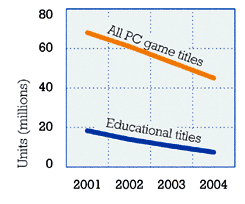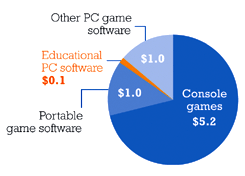Let the Games Begin: Entertainment Meets Education
Video games, once confiscated in class, are now a key teaching tool — if they’re done right.
Your content has been saved!
Go to My Saved Content.
Kurt Squire knew something unusual was happening in his after-school Western civ program. His normally lackluster middle and high school students, who'd failed the course once already, were coming to class armed with strategies to topple colonial dictators. Heated debates were erupting over the impact of germs on national economies. Kids who didn't know Pompeii from Plymouth Rock were suddenly mapping out the borders of the early Roman Empire.
His secret? Sid Meier's Civilization III, one of the best-selling computer games in recent years. "It drives so much activity that you need to cut it off at the end," he says.
Kids are not ambivalent when it comes to video games: They love them. Young boys, especially, have been pouring quarters into slots since Computer Space, the first commercial arcade video game, appeared nearly thirty-five years ago. While pixelated hits like Pong, Space Invaders, Pac-Man, and Donkey Kong first stole gamers' hearts, less glamorous educational titles, like Oregon Trail (1974) and Where in the World Is Carmen Sandiego? (1985), have held their own.
But there's one kind of game that nobody's succeeded in making for the insatiable throngs of game groupies: a blockbuster hit for the classroom.
Instead, school districts, eager to be perceived as plugged in and afraid of being penalized for low test scores, have bought into expensive drill-and-kill software -- the kind that costs a fortune and displays a silly animation of fireworks or cheering crowds for every five correct answers -- with only minimal improvements on test scores and scant evidence of long-term progress among students. Most administrators approach new game-software purchases with skepticism and a reluctance to spend money.
Meanwhile, the video game world has blossomed into a gargantuan $7-plus-billion-a-year industry. Kids (and their teachers, it turns out) spend more time per week blowing up aliens than watching television or (no surprise) doing homework. Although the so-called edutainment software titles, like the Blue's Clues and Dr. Seuss series, make up a relatively small portion of the market, academics, teachers, and entrepreneurs are working to transform a couch potato pastime into a curriculum staple. They're almost there.
Power Up
Video games can do a lot of things that traditional teaching cannot. As Squire's class showed, they can get unmotivated students fired up about -- can it be? -- ancient history. Games can also be an effective way of reaching students who haven't responded to conventional teaching methods, and they can get gifted students to apply critical-thinking, problem-solving, and other higher-level skills to subjects they already know.
It's not just especially low- or high-performing kids who benefit, says David Gibson, codirector of the SimSchool PT3 Project, a Vermont-based organization that develops a desktop game to train future teachers for the classroom. He believes games may be the key to "stealth education," whereby all kids have such a good time that they don't realize they're also learning (see "Games: Not Just Child's Play," below). "Education will be so much fun because it will be played and enacted," Gibson says.
So far, the data looks promising. "The whole point behind our research was to see if we could design games that would help the bottom third of students, students that even by middle school have given up on themselves and on school," explains Chris Dede, the Timothy E. Wirth Professor in Learning Technologies at the Harvard Graduate School of Education.
In a 2002 pilot study involving three middle school classrooms in Boston, Dede found that students who played his game River City surpassed the test group in three areas: They were more motivated to do the work, performed better on postlesson tests, and tended to look to their teachers to facilitate rather than give direction. "We see real hope in the early results from our research," Dede says, adding that he's not blindly committed to making video games succeed in the classroom. "Our goal is to see how much it's worth investing in," he says.

The DIY Approach
Instead of developing elaborate games for kids to play in the classroom, some pioneering teachers and researchers have found that having students design their own games is a great way to reinforce a lesson or connect it to other skills and ideas. That was the approach Yasmin Kafai took while under a no-strings-attached grant from Nintendo to develop an educational video game in the early '90s at the Massachusetts Institute of Technology.
"Everyone thought we'd develop the perfect educational video game," recalls Kafai, now an associate professor at the Graduate School of Education and Information Studies at the University of California -- Los Angeles. After interviewing game enthusiasts (ranging from six-year-olds to adults) about what the perfect formula might be, she began to wonder whether players might design a better game than she could.
So she tried it. A Boston fourth-grade math class was provided with some basic software, designed by Kafai, and assigned the task of creating a program to teach fractions to third graders. Kafai's goal was modest: to see if it is possible to combine a math lesson with a computer-skills lesson -- classic stealth learning. While the games themselves weren't visually outstanding, the kids who created them learned fractions and computer skills simultaneously, and they had fun creating flourishes like elaborate punishments and rewards for answers.
This approach, however, puts a lot of pressure on the teacher. Mary Karl, the coordinator for gifted and talented students at Forest Glen Elementary School, in Green Bay, Wisconsin, has her class write math games for other kids using MicroWorlds software. The student designers reinforce their knowledge of decimals and time and develop strategic and problem-solving skills. The kids who are behind then get to reinforce their own skills by playing the game. But, says Karl, "to navigate back and forth between the math of fractions and what kids are doing on the computer requires a teacher who feels very comfortable on both levels." An educator like that might be hard to come by. An off-the-shelf video game might be easier to work with.
Credit: Thomas ReisGone Shopping
Packed with geography and history, yet exciting enough to keep teen and adult players engaged for hours, Civilization III was, in many ways, already an educational game before Kurt Squire, an assistant professor of education technology at the University of Wisconsin-Madison, decided to try it out on groups of eleven- to fifteen-year-olds at an inner city Boston school. "You might think of it as a map in a history book come to life," Squire explains. Players choose a geographical region and develop it using only resources available 6,000 years ago. Slowly but surely, they obtain agriculture, architecture, knowledge. Trade routes are forged; diplomatic ties with other players are established. Civil unrest and natural disasters pose formidable challenges, as do invading forces from neighboring countries, especially when the invading force is also your playground nemesis.
Whereas Karl and Kafai discovered that by creating a game, students could reinforce a lesson they'd already learned, Squire found that a highly sophisticated mainstream game could help motivate students to understand things they couldn't, or wouldn't, learn before.
"The biggest thing we found in pre- and post-interviews was that these kids hate school-based history," Squire says. "The game really gave many of them a different way to learn it."
African-American students, for example, inspired by the possibility of overthrowing colonial oppressors, attempted to rewrite the history books through smart game play. "Some students were really interested in caring for their people, building a civilization, and making people happy. Others were into exploring, building boats, and sailing around the world," Squire recalls. Although the kids were competing against one another, this didn't stop, say, geography buffs from assisting warriors. As a bonus, students studied maps and encyclopedias of their own volition.
Still, integrating a game designed to entertain adults into a classroom full of teenagers wasn't easy. In his study, Squire discovered that the advanced vocabulary and complicated rules frustrated students, while teachers struggled to manage twenty-five kids doing twenty-five things at the same time. Also, because Civilization III teaches the underlying principles behind history, rather than names and dates, it didn't do much to help teachers prepare students for testing. Although Squire says the teachers he worked with were overall very positive, he adds, "This is not something I would throw on unsuspecting teachers." Squire has since published curriculum support and is developing an online network to aid teachers who wish to use Civilization III in their own classrooms.
Clearly, to make an educational video game really work, as the students demonstrated by bringing in outside reading, you need supplementary materials to go with it. Enter River City.

Package Deal
The residents of River City are suffering from a mystery ailment. Middle and high school kids, working in teams of three or four, can explore the virtual town, interacting with signs, characters, and each other as they create and test hypotheses for what's causing the illness. As they progress through the game, students gather information on epidemiology, biology, ecology, history, social studies, and statistical reasoning, which they evaluate to come up with their theory. It's a method that experienced gamers will find familiar.
"In a lot of video games, players are thrown into a complicated situation without explanation and wander around figuring out what power they have to do something. So River City builds on skills kids have developed in entertainment that turn out to be useful," says Harvard's Dede.
River City computer time is followed by teacher-led interpretive discussions. At the end of the eleven-day unit, teams must present to the rest of the class their hypotheses on what's causing the illness. (There are eight possible correct answers.) Meanwhile, supplementary materials provide the teacher with guidelines for final team presentations, as well as tools to measure things like student motivation, engagement, and productivity -- necessary because most teachers aren't going to know instinctively how to grade something as abstract as video game skills. River City is effective even if the teacher spends the lesson grading papers in the back of the computer lab. "It won't turn out as well if a teacher doesn't care, but there's enough support built into the software that students can get by," Dede says.
Few games available to teachers accomplish what River City does. The classroom game Making History, which lets students play various countries before, during, and after World War II, is one possible contender. Making History comes complete with curriculum, supporting materials, and tools that let teachers customize the game to match their lesson plans and generate reports for assessment. But it's been out only since January, too soon to determine how well it will go over.
Nick de Kanter, vice president of business development at Muzzy Lane Software, the game's publisher, notes that even with all the necessary bells and whistles, this game and others like it are a supplement, not a replacement, for good, old-fashioned teaching. "We see this not as the only way to teach history but as part of the whole process that will include lecture, textbook reading, and paper writing. But it will greatly enrich the process of doing all those things," he says.
And that's the hope, isn't it? Not that video games will take over the classroom but that they will provide teachers with one more useful tool to employ when the time is right. The early adopters, whose work has helped shape the progress of classroom video games, and the skeptics (see "Shut It Off," below), who rightly urge caution and further study, actually see eye to eye: Both wish to see computer games used in the classroom only if they truly enhance learning and benefit the students who need it most. And if everyone has a little fun along the way, better yet.
Jenn Shreve writes about technology and popular culture for a variety of publications.
Games: Not Just Child's Play
If games and simulations can be used to teach students, why not teachers, too? That's the premise behind a software program in development called SimSchool. The software will import real demographic data on a school district's student performance, personality, racial makeup, and even social characteristics to generate a realistic classroom mix. Would-be teachers will then input their lesson plans into the program and see how well individual students and the class as a whole respond.
David Gibson, codirector of the SimSchool PT3 Project, says the game will give teachers in training a chance to try out their lesson plans before subjecting an entire classroom to them. He also hopes that teaching teachers with a game will make them more willing to use games as part of their classroom instruction. "If we give them good educational games during training, it will be a model for them on how to integrate games into their own classrooms," he says. -- JS
Shut It Off
Video games in the classroom may score points with some educators and researchers, but not everyone is cheering.
Jane Healy, educational psychologist and author of Failure to Connect: How Computers Affect Our Children's Minds -- and What We Can Do About It (Simon & Schuster, 1999), believes that we not only haven't figured out how to make "intellectually appropriate and challenging and enriching" games for kids, we also don't yet understand the impact of gaming on kids' minds well enough to recommend this type of learning experience.
She's not alone. In his book Oversold and Underused: Computers in the Classroom (Harvard University Press, 2001), Larry Cuban argues that introducing computers into the curriculum without proper teacher training wastes time and money and detracts from kids' education. Similarly, a report titled Tech Tonic: Towards a New Literacy of Technology, put out by the Alliance for Childhood last September, asserts that there's inadequate evidence to support claims that video games improve student performance, while overreliance on technology is contributing to rising childhood-obesity rates. Edward Miller, editor of the Tech Tonic report, urges decision makers to consider the downsides before going "blithely on with more and more high-tech activities that are squeezing out traditional types of low-tech activities."
Neither Healy nor Miller is adamantly against using video games or simulations (like Harvard-developed River City) in the classroom. In fact, Healy says, "simulations can be like a game, and at the right age, around seventh or eighth grade, some research shows that in math it works if you do it really well and have great teachers and the right equipment." For game developers like Marc Prensky, however, waiting for the ideal situation before introducing games into the classroom is a mistake. "The commercial world is promising and delivering," he says, and traditional teaching methods simply can't compete with the appeal of a commercial world of games that makes children heroes or puts the fate of Harry Potter in their hands. "Kids don't want to power down. It's a fight out there, an intellectual competition," Prensky says.
Healy compares that argument to exposing yourself to a disease just because everyone is dying of it. She argues, "Kids are interested in learning. They want to acquire information, and if they have two-second minds because of video games at home, that doesn't mean the school needs to exacerbate the situation."
"As a society, we have to decide if we want kids to focus and reflect long enough to read text and understand it. We need to be very careful about introducing extremely dynamic and distracting visual environments, irrespective of what they might be teaching." -- JS